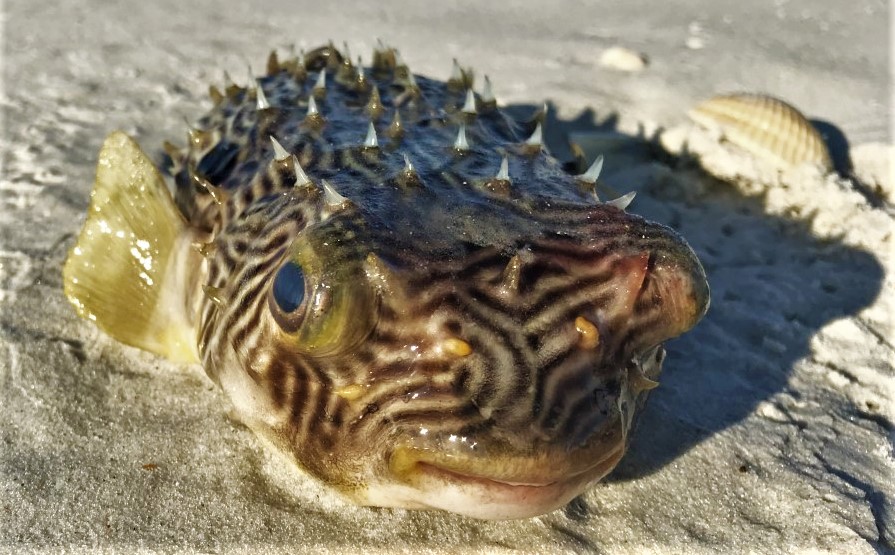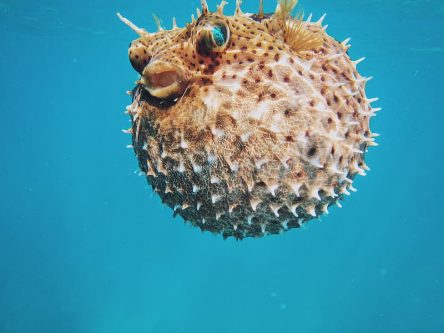
The Southern Puffer is poorly studied with very limited information available about their lifestyle and behavioral patterns including specific details on age, growth, longevity, movement patterns, diet, habitat use, and reproduction. Eggs are laid demersal and attach themselves to rock and coral surfaces they hatch quickly and larvae are pelagic. Reproduction is oviparous with external fertilization. They feed on shellfish, crustaceans, and small fish. They are reported to accumulate toxins including the potent neurotoxins saxitoxin and tetrodotoxin in their skin, gonads, and liver to deter predator attacks. They are also capable of inflating their abdomen with water when frightened or disturbed. They are normally solitary individuals but are known to form loose aggregations around man-made structures. They have the ability to survive in a wide range of salinities (5 ppm to 45 ppm). They are active during the day and settle into sandy bottoms at night. They reach a maximum length 25.0 cm (9.8 inches) in length. The Southern Puffer is found in coastal and estuarine habitats in shallow protected waters at depths up to 18 m (60 feet) and have an affinity for mangroves and seagrasses. They do not have pelvic fins, fin spines or scales. Their anal fin has 6 rays and a short base and, their dorsal fin has 7 rays and a short base. Their head is blunt with a small terminal mouth and 4 fused teeth that form a strong beak. Breeding males are covered with small bright orange or red spots. They have large dark splotches along their lower sides, variable dark slashes on their lower cheek, a dark bar between their eyes, and a dark pectoral fin base. They transition to light brown ventrally. They are dark brown and covered with darker and lighter spots and blotches, many having pale tan rings and semicircles. The Southern Puffer has a thick, oblong, and inflatable body. Globally, there are twenty-three species in the genus Sphoeroides, of which thirteen are found in Mexican waters, eight in the Atlantic and five in the Pacific Ocean. The Southern Puffer, Sphoeroides nephelus, is a member of the Puffer or Tetraodontidae Family, and is known in Mexico as botete fruta or simply just botete. Catch, photograph, and identification courtesy of Josh Leisen (), Gaylord, Michigan. Fish caught from coastal waters off Key Largo, Florida, March 2017. Catch, photograph, and identification courtesy of Dean Kimberly, Atlanta, Georgia. Fish caught from coastal waters off Key West, Florida, March 2017. Catch, photograph and identification courtesy of Ryan Crutchfield, Tampa, Florida. Fish caught off the Dunedin Causeway, Dunedin, Florida, March 2016. Catch, photograph and identification courtesy of Ben Cantrell, San Diego, California. Southern Puffer, Sphoeroides nephelus. Fish caught from coastal waters off Tampa, Florida, May 2018. Catch, photograph and identification courtesy of Eli (). Fish caught from coastal waters off Clearwater, Florida, March 2012. Catch, photograph and identification courtesy of Marc Eberlein, Grand Rapids, Michigan. Fish caught off the Sanibel Island Pier, Sanibel Island, Florida, March 2017.

Bivalves or Pelecypod Shells – by Genus and Species.Bivalve or Pelcypod Shells – by Common Name.


And they’re not coming from offshore waters.

So far, many specimens over 20-inches have been caught. These are NOT the small porcupine blowfish that usually cut chunks from soft plastic baits and steal live shrimp. Likely a deepwater species, I’d never seen one until I caught 4 off Steinhatchee on Florida’s Big Bend last year. Since the spring of 2015, there’s been an “outbreak” of smoothback puffers along Florida’s Gulf Coast, from Tampa Bay to Pensacola. Smoothback Puffer Lagocephalus inermis, Family:Tetrodontidaeįrom Tommy Thompson, Natural North Florida Fishing Expert


 0 kommentar(er)
0 kommentar(er)
